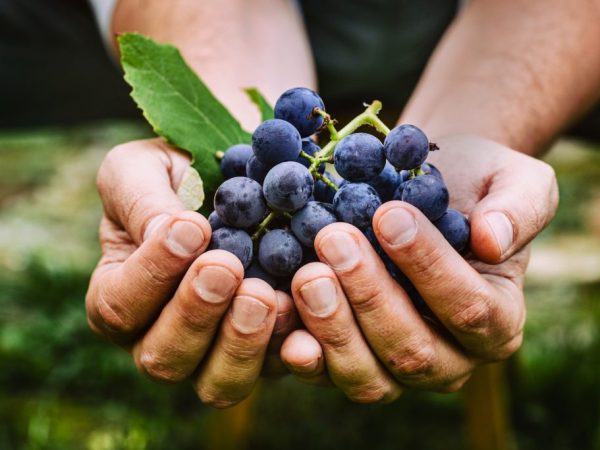How to grow grapes Northern Shoulder
One of the interesting varieties is the Northern Shoulder grape. It contains a huge amount of vitamins and minerals in the composition, especially necessary for residents of regions with a harsh climate.

Growing grapes Northern Shoulder
Characteristics of the variety
Grapes are ancient varieties. It appeared on the Don, got its name because of its shape, the "shoulders" of the bunch.
For the grapes of the Northern Shpokistik variety, people came up with several more names:
- Goryun (looks like a mountain);
- Scarf, because the berries are crumbling;
- Black wine due to the dark color of the berries;
- Horned brush due to the shape of the brush.
The variety shows resistance to frost, it is successfully grown in different regions of the country.
The Northern Shoulder is not resistant to diseases, therefore it requires protective measures against fungal and viral diseases.
The variety is picky about the composition of the soil and its moisture. When planting, it is important to carry out a preliminary analysis of the soil, to ensure regular watering to obtain a good yield.
Description of the vine
The derived species has the following characteristics of the vine:
- great strength of growth;
- good maturity;
- frost resistance up to -32 ° C;
- average ripening period.
From the moment the buds bloom and until the harvest is fully ripe, it takes 130 days. Mass collection begins in the last days of August or the first week of September (in the southern regions). Closer to the north, the grapes ripen by September 20.
Foliage description
The leaves are distinguished by small notches on the sides. Veins are clearly visible on them, they are dense, with pronounced teeth.
The quality of the leaves, their density on the vine, makes it possible to decorate the site with grapes. Summer gazebos look good. It is pleasant to relax in their shade in the summer heat.
Expressive, dense, medium-sized leaves look great for decorative zoning.
Description of fruits

The fruit tastes sweet
Berries, according to the description, have the following characteristics:
- moderate density;
- round form;
- weight - from 1 to 2 g;
- blue with a purple tint color;
- thin skin;
- sugar content - 25%;
- acidity - 7 g / l.
The peel, despite its strength, is thin and delicate in taste. There is a small white bloom on the berries. The taste is sweet, with a slight sourness. There are few seeds, they move well from the pulp.
Features of agricultural technology
A feature of this grape is that the colder the climate in which it grows, the tastier and healthier the berries are. To grow the Northern variety, you need to take into account some of the tricks and subtleties of agricultural technology.
Landing
For planting, they are waiting for the ground to warm up. It should thaw at least half a meter. In the northern regions, this occurs at the end of May or early June.
To wait for favorable weather, the shoulder strap is dropped into a container and left in a place where there are no drafts.
Uniform heating of the soil is achieved by digging trenches along the entire planting, from its southern side.The melted water will move away faster, the earth will quickly heat up to the desired temperature throughout its depth.
If it is impossible to dig a trench (there is little space or there is simply no way to drip in this place), the grapes should be planted in bulk ridges up to 70 cm high, located in an east direction. This increases the temperature by 2 ° C, the intensity of the growth of the kidneys and the even distribution of light. With this method of planting, rotting from excess moisture does not threaten the root system.
Fertilizer
The vine grows intensively and requires additional nutrients. With a ridge planting, the intensity of their consumption increases significantly.
Soil enrichment is carried out several times per season. In the first decade of May, 10-12 kg of rotted manure or other organic matter is introduced under each bush. This helps the growth and development of shoots, slows down the leaching of essential minerals due to rain. Fertilizer is laid out under the bushes and is not added with anything. This makes it possible to receive nutrition through the lower row of leaves, and then through the root system.
In the northern regions, fertilizers should be applied in proportion to the harvest received last year. This is the main feature of the fertilization procedure for this variety.
Disease prevention
The northern shoulder is distinguished by its resistance to diseases, but this does not mean that there is no need to take any measures to protect it.
It is important to regularly prune and thin out shoots and foliage. Excessive ovaries interfere with airing and contribute to the appearance of fungus. The bush does not receive enough sunlight, a favorable flora for pathogens is formed in the thickened part.
Every 7-10 days, they work on the foliage with a fungicide and an insecticide to exclude the possibility of damage to the future crop by pests.
Conclusion
There is no better grape for homemade wine or juice than the Northern one, with its rich taste and peculiar aroma. It keeps well.

